DESCRIPTION AND OPERATION
All Wheel Drive (AWD) Systems
The AWD system consists of the following:
- PTU
- Rear driveshaft
- AWD relay module
- Rear axle with ATC solenoid
Torque from the engine is transferred through the transmission to the PTU. This torque is transferred from the driveshaft to the rear axle, which controls torque to the rear halfshafts. The AWD system is always active and requires no driver input.
The AWD system continuously monitors vehicle conditions and automatically adjusts the torque distribution between the front and rear wheels. During normal operation, most of the torque is delivered to the front wheels. If wheel slip between the front and rear wheels is detected, if the vehicle is under heavy acceleration or if the vehicle is in an aggressive handling event, the AWD system increases torque to the rear wheels to prevent or control wheel slip. When the AWD system is functioning properly, there should be no perceived speed difference between the front and rear axles when launching or driving the vehicle on any uniform surface. Traction should be similar to a part time 4WD system in 4H ( 4X4 HIGH), but have no binding in turns.
Serviceable components of the PTU are limited to the output shaft seal and flange, intermediate shaft seal and deflector, and the PTU transmission compression seal. No internal components are serviced. There should be no need to remove the PTU cover. If any of the internal geared components, bearings, case cover or shafts are worn or damaged, a new PTU must be installed.
Police vehicles and SHO Track Pack vehicles will include a PTU cooler and PTU oil minder information. The PTU in Taurus SHO Track Pack and police interceptor vehicles does not require any normal scheduled maintenance. The system is electronically monitored and notifies the driver of required service by displaying the message "Change AWD Power Transfer Unit Lube" in the information display. The PTU lube will be more likely to require a fluid change if the vehicle has experienced extended periods of extreme/severe duty cycle driving. Do not check or change the PTU lubricant unless the unit has been submerged in water, shows signs of leakage or a message indicating required service is displayed. To reset the PTU lube life monitor, refer to Power Transfer Unit (PTU) Oil Life Monitor Reset.
DIAGNOSIS AND TESTING
All Wheel Drive (AWD) Systems
Principles of Operation
The AWD system is an active system, which means it not only responds to wheel slip between the front and rear axles but also has the ability to anticipate wheel slip and transfer torque to the rear wheels before the slip occurs. The AWD system is active all the time and requires no input from the operator.
The AWD system continuously monitors vehicle conditions and automatically adjusts the torque distribution between the front and rear wheels. During normal operation, most of the torque is delivered to the front wheels. If wheel slip between the front and rear wheels is detected, if the vehicle is under acceleration or if the vehicle is in an handling event, the AWD system increases and distributes torque to the rear wheels as needed. When the AWD system is functioning properly, there should be no perceived speed difference between the front and rear axles when launching or driving the vehicle on any non-uniform surface. Traction should be similar to a part time 4WD system in 4H ( 4X4 HIGH), but have no binding in turns.
If the compact spare tire is installed, the AWD system may disable automatically and enter FWD only mode to protect driveline components. This condition may be indicated by an AWD OFF message in the message center.
If there is an AWD OFF message in the message center from using the compact spare tire, this indicator should turn off after reinstalling the repaired or replaced normal road tire and cycling the ignition OFF and ON. It is recommended to reinstall the repaired or replaced road tire as soon as possible. Major dissimilar tire sizes between the front and rear axles could cause the AWD system to stop functioning and default to FWD or damage the AWD system.
AWD faults will be indicated by the powertrain malfunction (wrench) message center warning indicator in the IPC as well as the Check AWD message center warning indicator in the message center.
The AWD system consists of a PTU , driveshaft, front and rear halfshafts, AWD relay module, PCM which includes the AWD control logic and an ATC solenoid located in the rear axle. Based on inputs to the PCM, the PCM sends a command to the AWD relay module. The amount of torque sent to the rear wheels is controlled by the AWD relay module sending a PWM duty cycle to the ATC solenoid.
The PCM provides the brake system with its current clutch command torque level and determines wether or not the brake system may take command of the AWD clutch.
NOTE: The ATC solenoid is not repairable. If a new component is required, the ATC solenoid and rear axle are installed as an assembly. Refer to Section 205-02.
PCM inputs are:
- Various engine and transmission signals received internally
- Various signals received internally via HS CAN from the ABS module
- Diagnostic information from the AWD relay module
PCM outputs are:
- Solid-state clutch PWM signal to the ATC solenoid
Heat Protection ( RDU )
During very extreme off-road operation, the AWD system utilizes a heat protection mode to protect the AWD clutch from damage. If the AWD system detects an overheat condition, it enters a locked mode. If the heat in the AWD system continues to rise once in the locked mode, the PCM disables the ATC solenoid. This condition may be indicated by an AWD OFF message in the message center. To resume normal AWD function as soon as possible, stop the vehicle in a safe location and stop the engine for at least 10 minutes. After the engine is restarted and the AWD system has adequately cooled down, the AWD OFF message will turn off and normal AWD operation will return. In the event the engine is not stopped, the AWD OFF message will turn off when the system cools and normal AWD operation returns.
AWD Bar Code Identification
The AWD system on this vehicle is equipped with a bar coded ATC solenoid to reduce the tolerance of electrical current to torque delivered by the ATC solenoid. The ATC solenoid bar code can be found etched on the ATC solenoid wire harness connector protruding from the top of the rear drive axle or on the bottom of the RDU. The PCM uses this bar code information to match the clutch characteristics of the ATC solenoid with the desired output torque. If the bar code information does not match the PCM information, driveline damage or driveability concerns can occur. Therefore, if the PCM needs to be replaced, the new PCM will need to be configured with the existing ATC solenoid bar code information. If the rear drive axle need to be replaced, the existing PCM will need to be configured with the new ATC solenoid bar code information. Carry out the AWD Drive Cycle.
Steel Cover RDU
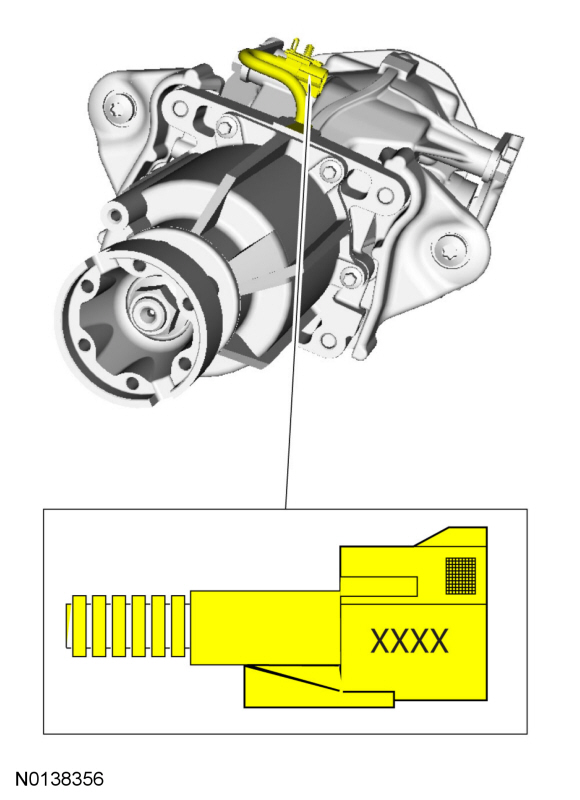
Aluminum Cover RDU
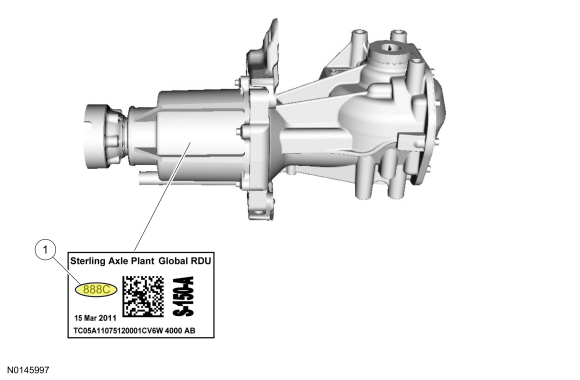
- ATC solenoid bar code
AWD Drive Cycle
Carry out the AWD drive cycle after downloading the ATC solenoid bar code information to the PCM.
NOTE: Always drive the vehicle in a safe manner according to driving conditions and obey all traffic laws.
- Carry out 3 accelerations from 0-48 km/h (0-30 mph) in a straight line.
- Perform this procedure at low, medium and full accelerator pedal position.
- Verify that there is no perceived front wheel slip.
- On dry pavement, drive the vehicle at 8 km/h (5 mph) in a fully locked
turn.
- Verify that there is no driveline binding.
Inspection and Verification
- Verify the customer concern.
- Inspect for obvious signs of mechanical or electrical damage.
Visual Inspection Chart
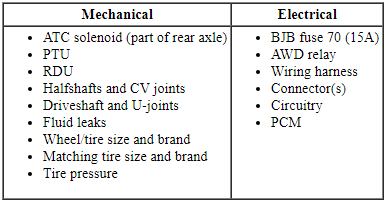
- If the DTCs retrieved are related to the concern, go to the DTC Chart. For all other DTCs, refer to Section 419-10.
- If no DTCs related to the concern are retrieved, GO to Symptom Chart.
DTC Chart
Diagnostics in this manual assume a certain skill level and knowledge of Ford-specific diagnostic practices. Refer to Diagnostic Methods in Section 100-00 for information about these practices.
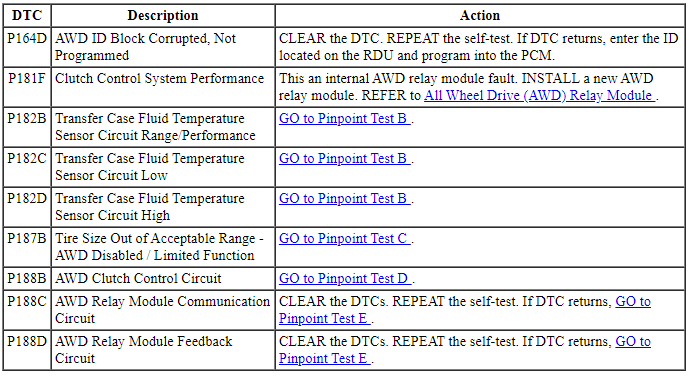
Symptom Chart
Diagnostics in this manual assume a certain skill level and knowledge of Ford-specific diagnostic practices. Refer to Diagnostic Methods in Section 100-00 for information about these practices.
In most circumstances, the PCM sets DTCs to help guide with diagnostics. Refer to the DTC Chart before using the symptom chart. The Condition column lists the vehicle condition. The Source column lists a detailed vehicle condition. The Action column lists the action to be performed to determine the cause of the condition. Each action lists the components that can caused the system and the individual components in that system. The components are listed in order of disassembly. Use the list of components and the required action to focus on disassembly inspections for the root cause of the concern.
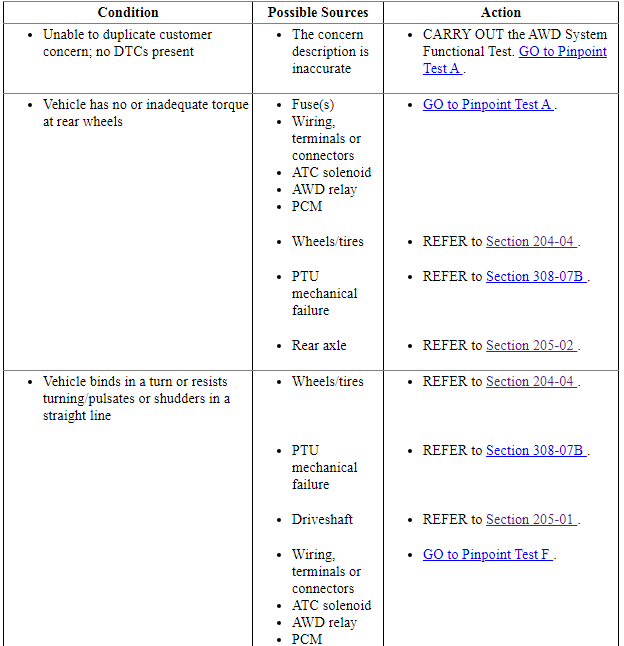
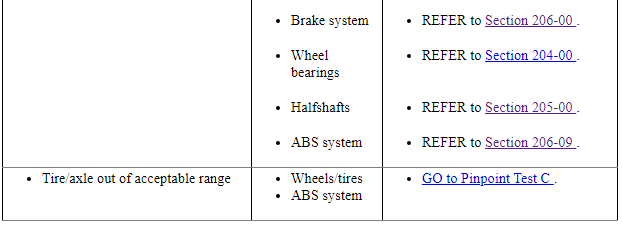
Pinpoint Tests
Pinpoint Test A: AWD System Functional Test
Diagnostic Overview
Diagnostics in this manual assume a certain skill level and knowledge of Ford-specific diagnostic practices. Refer to Diagnostic Methods in Section 100-00 for information about these practices. This pinpoint test is intended to diagnose the AWD system concern without on-demand or continuous DTCs.
Refer to Wiring Diagrams Cell 34 , All Wheel Drive (AWD) for schematic and connector information.
Normal Operation and Fault Conditions
The AWD system is an active system, which means it not only responds to wheel slip between the front and rear axles but also has the ability to anticipate wheel slip and transfer torque to the rear wheels before the slip occurs. The AWD system is active all the time and requires no input from the operator. The AWD system continuously monitors vehicle conditions and automatically adjusts the torque distribution between the front and rear wheels. During normal operation, most of the torque is delivered to the front wheels. If wheel slip between the front and rear wheels is detected, if the vehicle is under acceleration or if the vehicle is in an handling event, the AWD system increases and distributes torque to the rear wheels as needed. When the AWD system is functioning properly, there should be no perceived speed difference between the front and rear axles when launching or driving the vehicle on any non-uniform surface. Traction should be similar to a part time 4WD system in 4H ( 4X4 HIGH), but have no binding in turns.
PINPOINT TEST A: AWD SYSTEM FUNCTIONAL TEST
WARNING: When directed to drive the vehicle as part of this test, drive the vehicle on a hard surface in an area without traffic to prevent a crash. Failure to follow these instructions may result in personal injury.
NOTE: Check related modules for DTCs. If DTCs are set in other modules, diagnose those DTCs first before continuing.
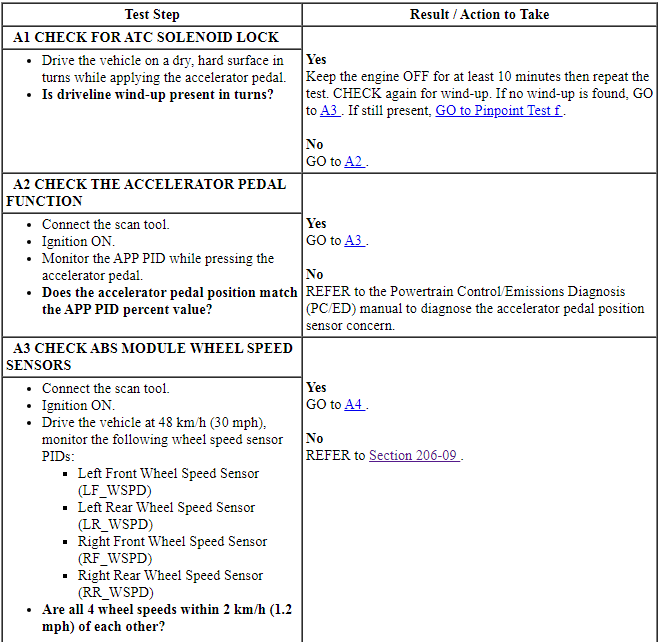
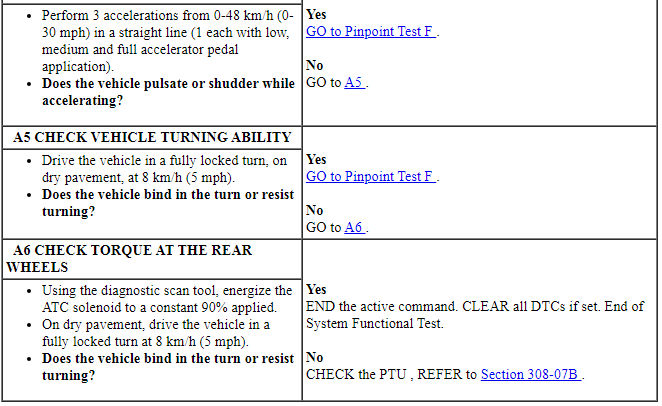
Pinpoint Test B: P182B, P182C, P182D
Diagnostic Overview
Diagnostics in this manual assume a certain skill level and knowledge of Ford-specific diagnostic practices. Refer to Diagnostic Methods in Section 100-00 for information about these practices. This pinpoint test is intended to diagnosis the wiring, terminals or connectors and the PCM.
Refer to Wiring Diagrams Cell 24 , Electronic Engine Controls - 3.5L/3.7L TiVCT for schematic and connector information.
Refer to Wiring Diagrams Cell 25 , Electronic Engine Controls - 3.5L GTDI for schematic and connector information.
Normal Operation and Fault Conditions
This transfer case fluid temperature sensor is located in the PTU. It is a temperature-sensitive device called a thermistor. The resistance value of the sensor varies with temperature change. The PCM monitors the voltage across the transfer case fluid temperature sensor to determine the temperature of the PTU fluid temperature.
DTC Fault Trigger Conditions

-
Possible Sources
- Connectors damaged or pushed-out terminals, corrosion, loose wires and missing or damaged seals
- Transfer case fluid temperature sensor
- PCM
PINPOINT TEST B: P182B, P182C, P182D
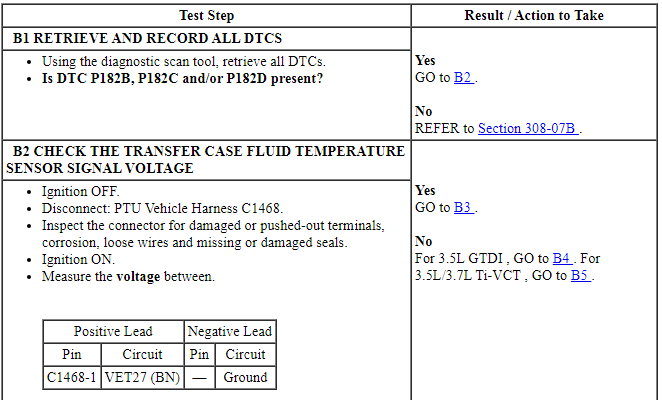
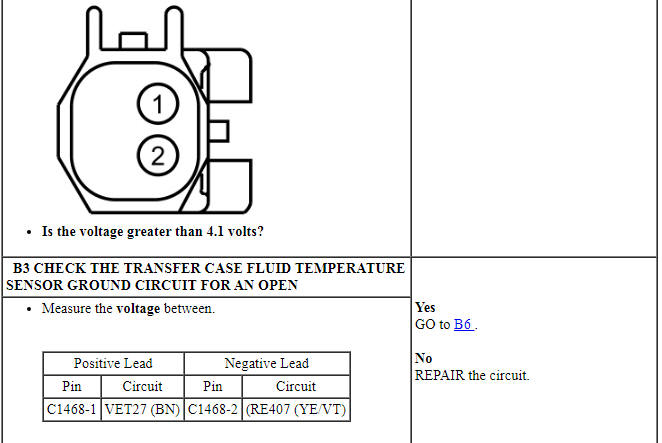
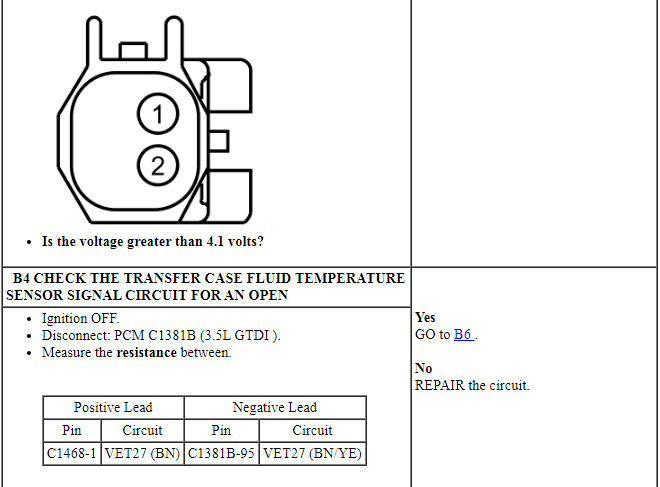
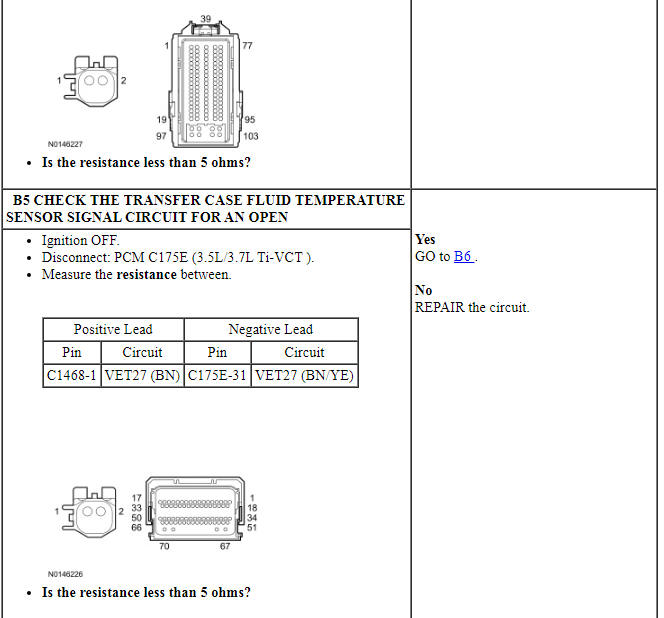
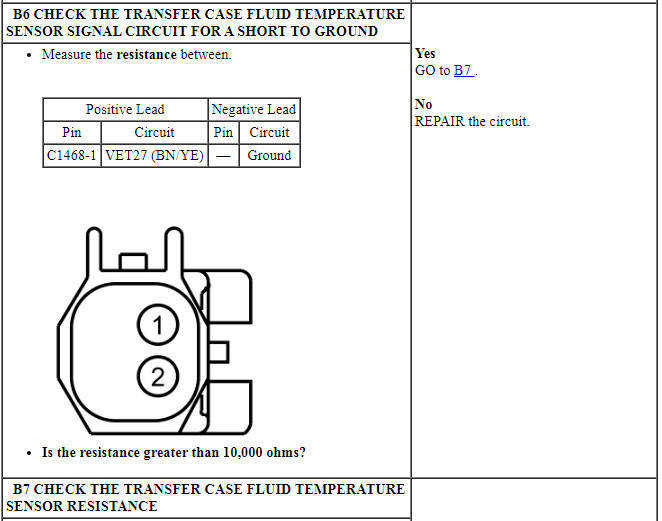
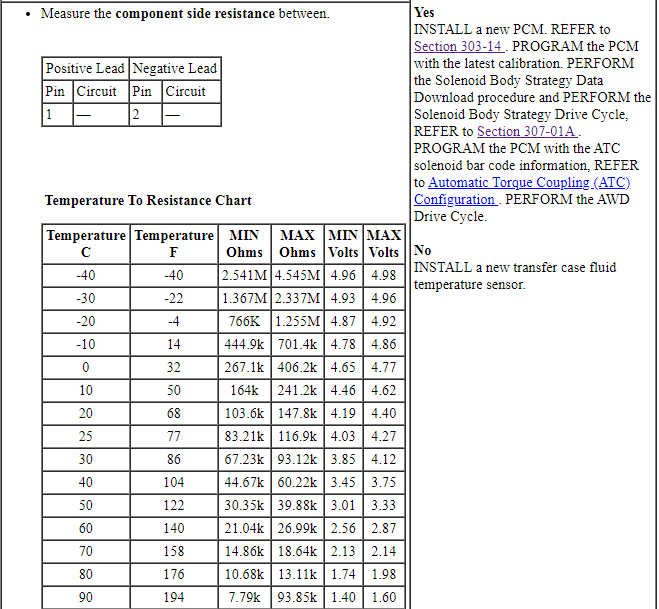
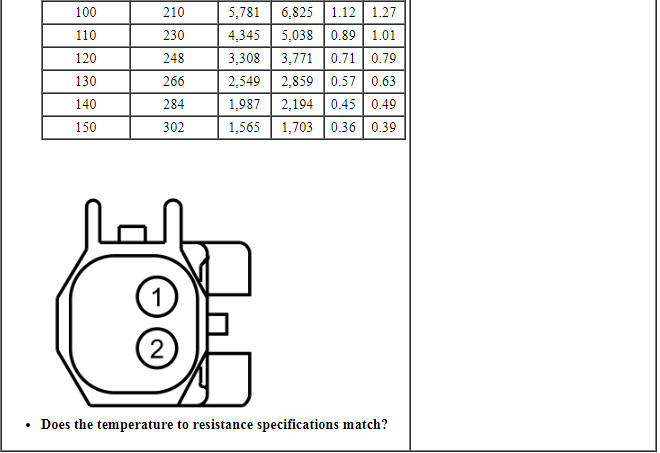
Pinpoint Test C: P187B
Diagnostic Overview
Diagnostics in this manual assume a certain skill level and knowledge of Ford-specific diagnostic practices. Refer to Diagnostic Methods in Section 100-00 for information about these practices. This pinpoint test is intended to diagnosis the wheels and tires, wheel speed sensors ABS module and PCM.
Refer to Wiring Diagrams Cell 34 , All Wheel Drive (AWD) for schematic and connector information.
Normal Operation and Fault Conditions
The AWD system uses input data from the ABS module wheel speed sensor inputs to the PCM. A dissimilar spare tire size (other than the spare tire provided) or major dissimilar tire sizes or improperly inflated tires between the front and rear axles could cause the AWD system to stop functioning correctly.
DTC Fault Trigger Conditions

-
Possible Sources
- Connectors damaged or pushed-out terminals, corrosion, loose wires and missing or damaged seals
- Incorrect tire(s)
- PCM
PINPOINT TEST C: P187B
WARNING: When directed to drive the vehicle as part of this test, drive the vehicle on a hard surface in an area without traffic to prevent a crash. Failure to follow these instructions may result in personal injury.
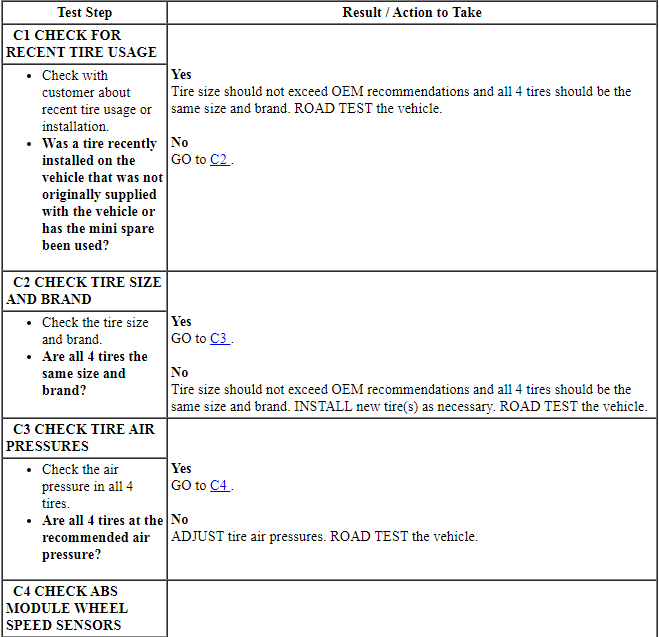
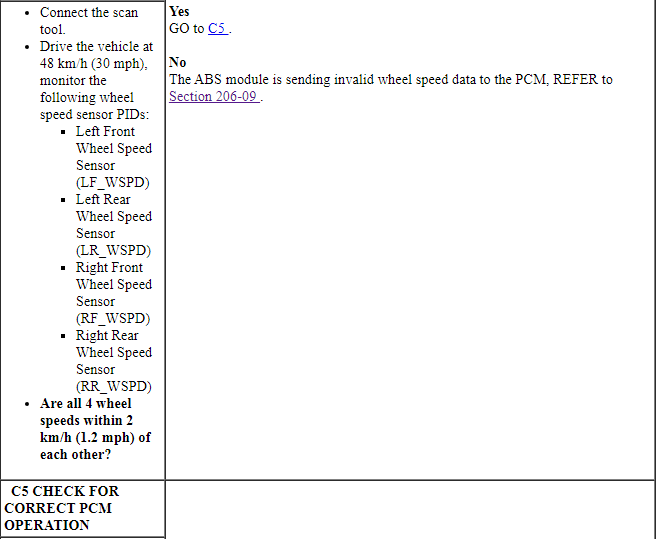
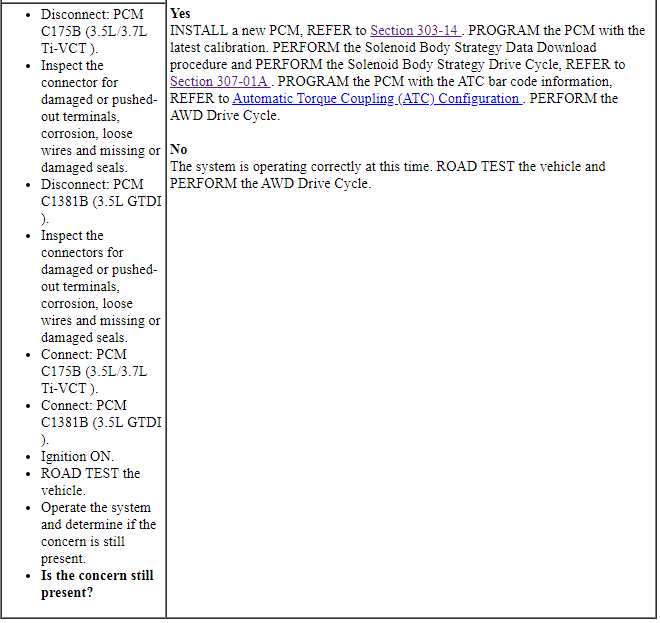
Pinpoint Test D: P188B
Diagnostic Overview
Diagnostics in this manual assume a certain skill level and knowledge of Ford-specific diagnostic practices. Refer to Diagnostic Methods in Section 100-00 for information about these practices. This pinpoint test is intended to diagnosis the wiring, terminals, connectors, AWD relay and PCM.
NOTE: Fuse 70 (15A) is HOT at all times and protects multiple components. Check related systems that may be inoperative.
Refer to Wiring Diagrams Cell 34 , All Wheel Drive (AWD) for schematic and connector information.
Normal Operation and Fault Conditions
The AWD system uses data from other systems as inputs to the PCM. The PCM uses the inputs to determine the appropriate time to send a signal and have the AWD relay energize the ATC solenoid.
DTC Fault Trigger Conditions

-
Possible Sources
- Connectors damaged or pushed-out terminals, corrosion, loose wires and missing or damaged seals
- ATC solenoid
- PCM
PINPOINT TEST D: P188B
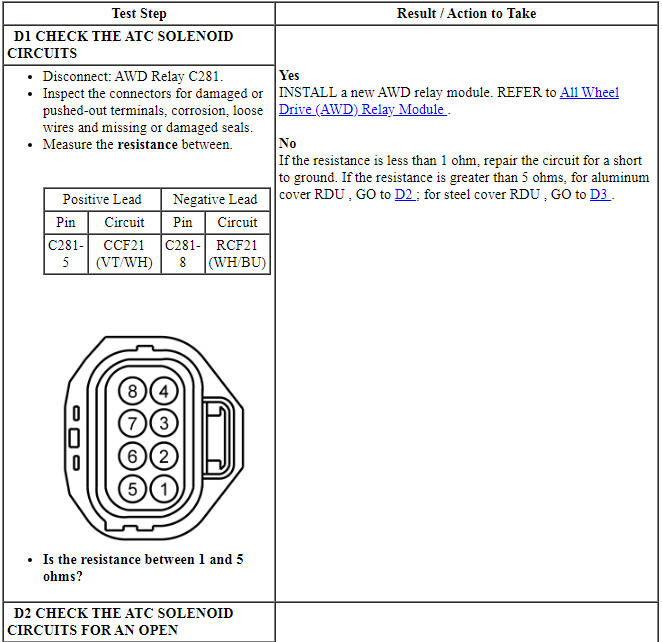
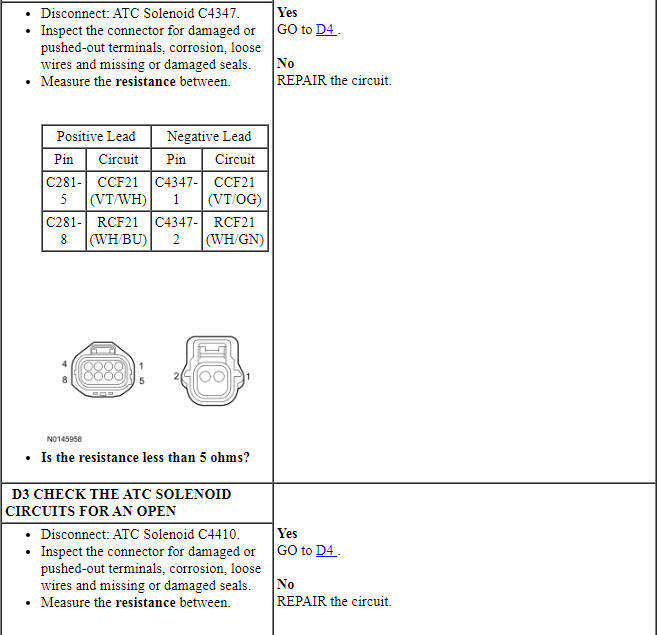
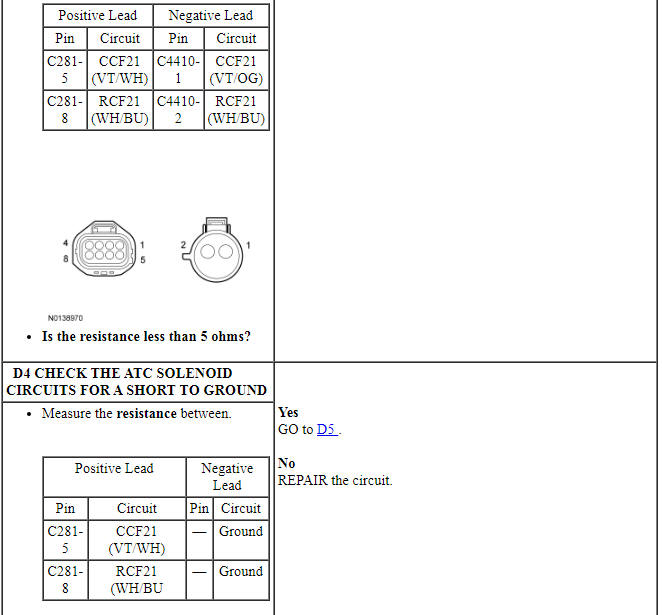
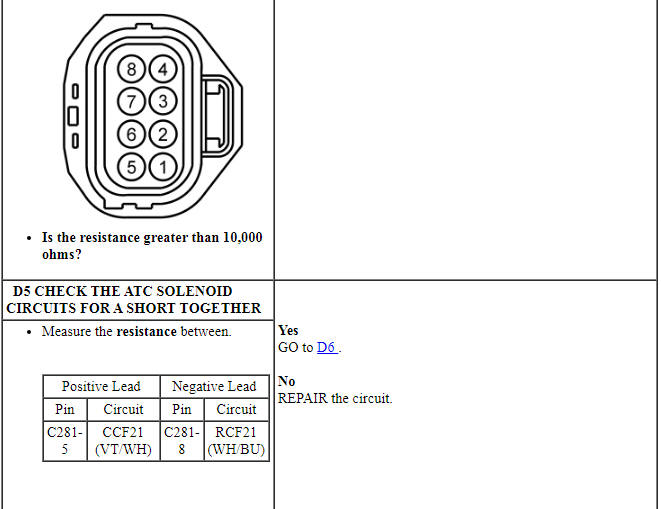
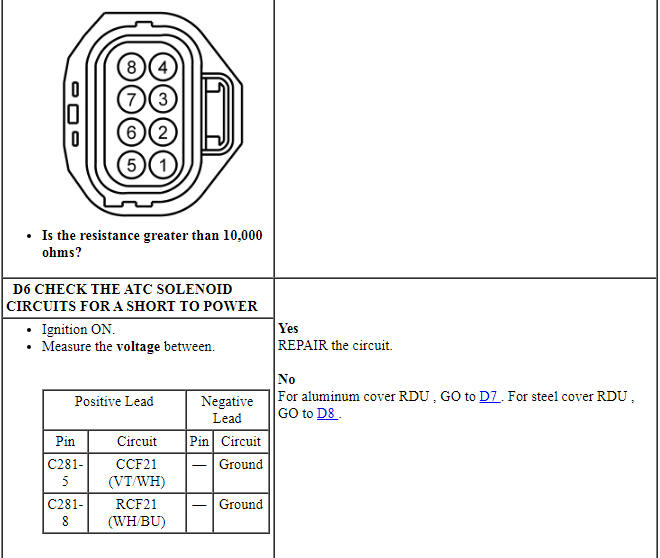
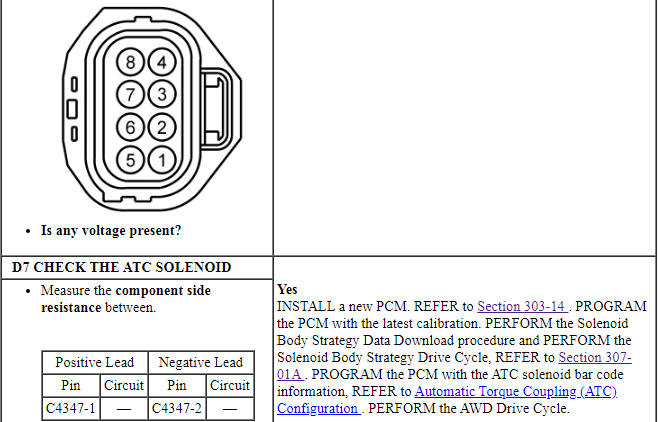
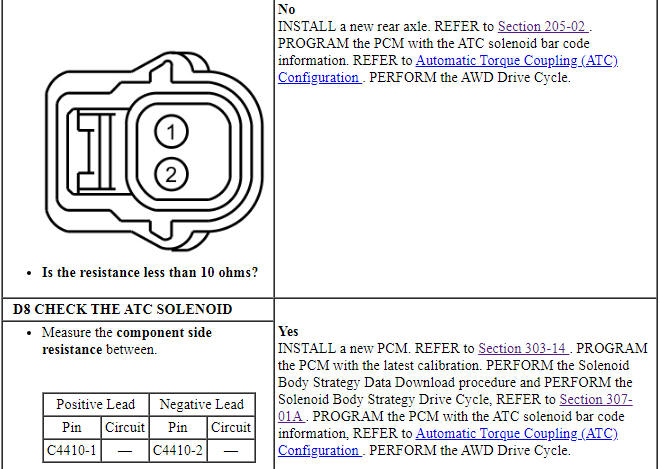
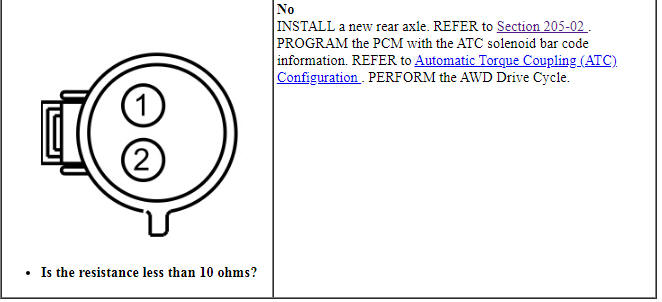
Pinpoint Test E: P188C, P188D
Diagnostic Overview
Diagnostics in this manual assume a certain skill level and knowledge of Ford-specific diagnostic practices. Refer to Diagnostic Methods in Section 100-00 for information about these practices. This pinpoint test is intended to diagnosis the wiring, terminals, connectors, AWD relay and PCM.
NOTE: Fuse 70 (15A) is HOT at all times and protects multiple components. Check related systems that may be inoperative.
Refer to Wiring Diagrams Cell 34 , All Wheel Drive (AWD) for schematic and connector information.
Normal Operation and Fault Conditions
The AWD system uses data from other systems as inputs to the PCM. The PCM uses the inputs to determine the appropriate duty cycle to send to the AWD relay on the command circuit and returns AWD relay information on the feedback circuit.
DTC Fault Trigger Conditions

-
Possible Sources
- Connectors damaged or pushed-out terminals, corrosion, loose wires and missing or damaged seals
- Fuse
- AWD relay module
- PCM
PINPOINT TEST E: P188C, P188D
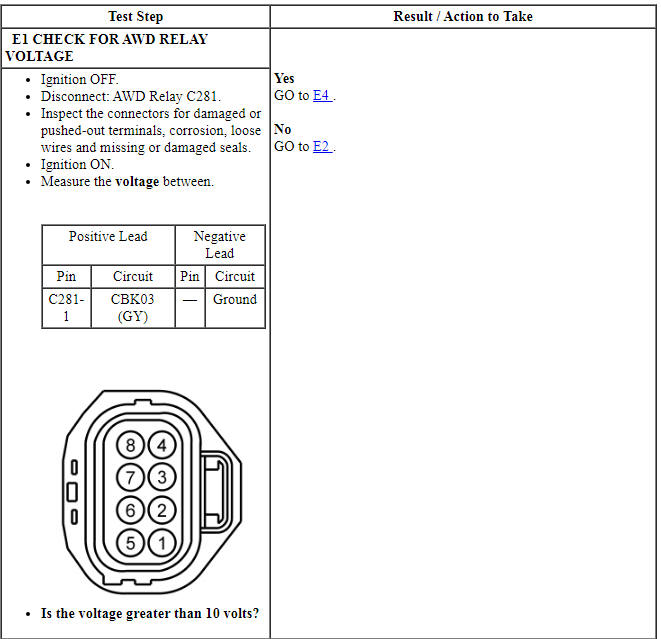
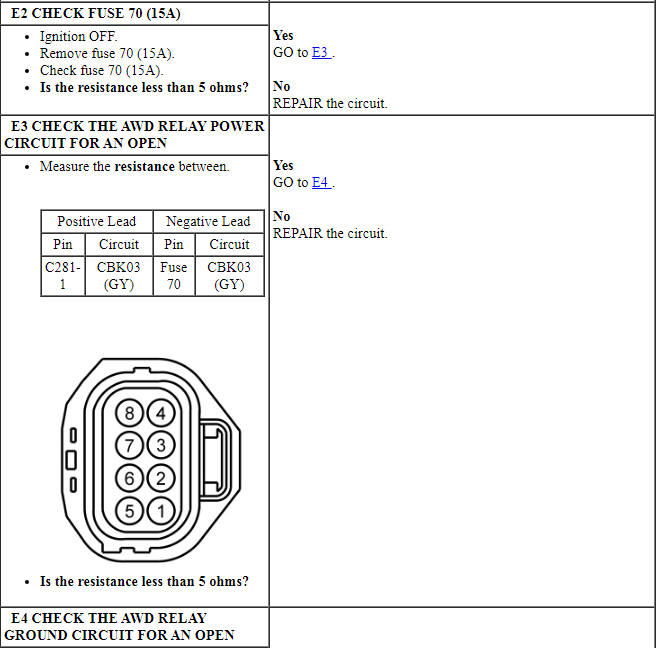
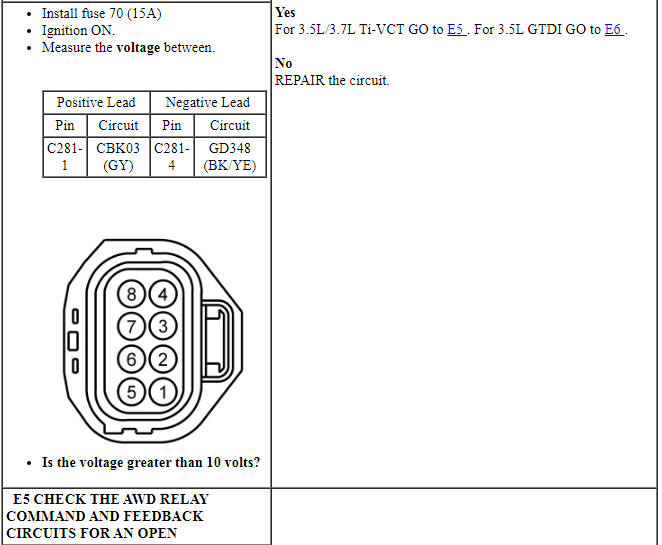
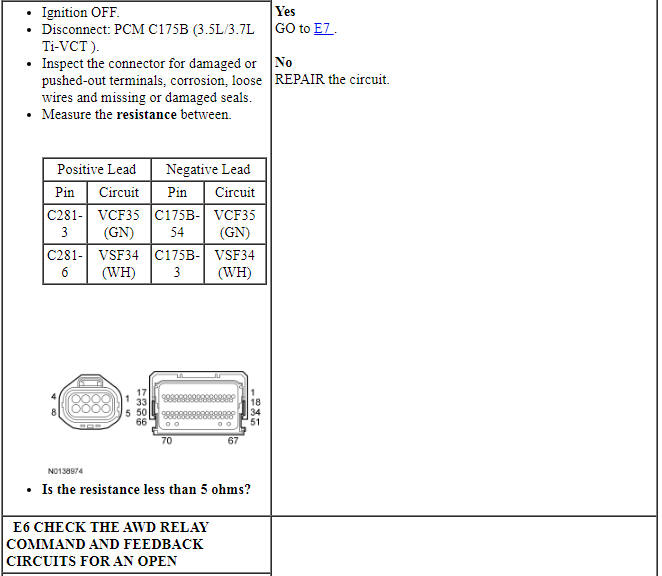
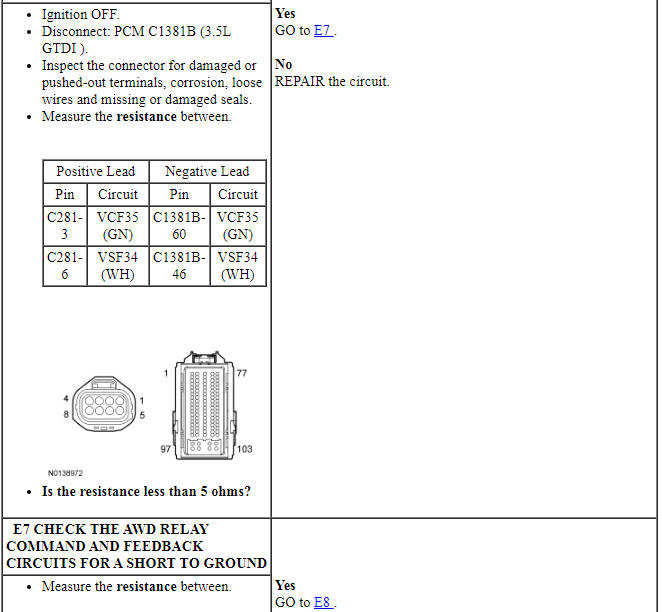
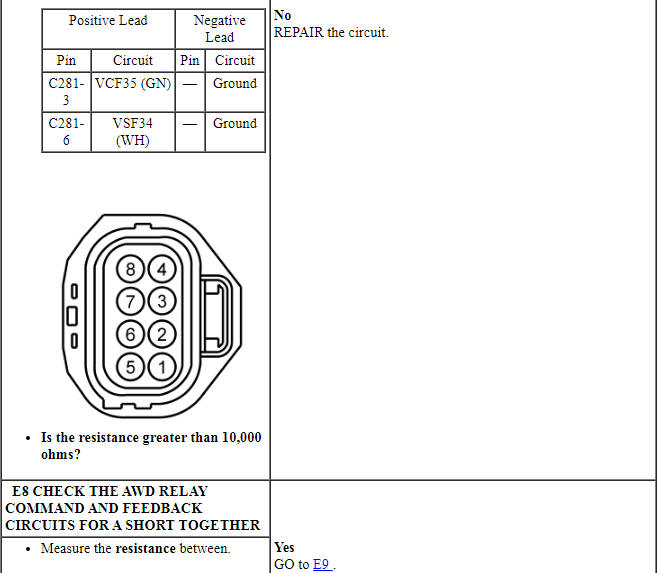
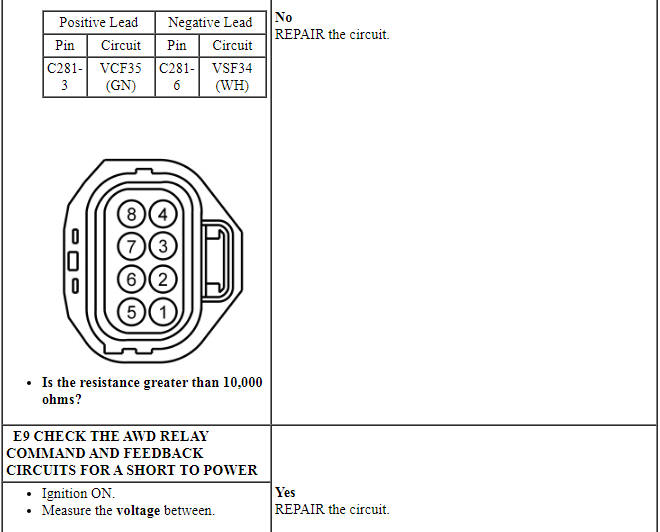
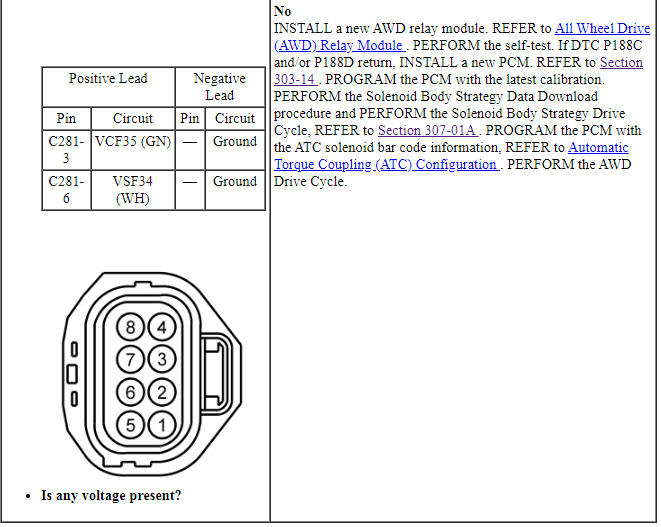
Pinpoint Test F: Vehicle Binds in a Turn or Resists Turning/Pulsates or Shudders in a Straight Line
Diagnostic Overview
Diagnostics in this manual assume a certain skill level and knowledge of Ford-specific diagnostic practices. Refer to Diagnostic Methods in Section 100-00 for information about these practices. This pinpoint test is intended to diagnose the wiring, terminals, connectors, wheels and tires, rear axle, ABS module, PCM and AWD relay.
Refer to Wiring Diagrams Cell 34 for schematic and connector information.
Normal Operation and Fault Conditions
The AWD system is an active system, which means it not only responds to wheel slip between the front and rear axles but also has the ability to anticipate wheel slip and transfer torque to the rear wheels before the slip occurs. The AWD system is active all the time and requires no input from the operator. The AWD system continuously monitors vehicle conditions and automatically adjusts the torque distribution between the front and rear wheels. During normal operation, most of the torque is delivered to the front wheels. If wheel slip between the front and rear wheels is detected, if the vehicle is under acceleration or if the vehicle is in an handling event, the AWD system increases and distributes torque to the rear wheels as needed. When the AWD system is functioning properly, there should be no perceived speed difference between the front and rear axles when launching or driving the vehicle on any uniform surface. Traction should be similar to a part time 4WD system in 4H ( 4X4 HIGH), but have no binding in turns.
PINPOINT TEST F: VEHICLE BINDS IN A TURN OR RESISTS TURNING/PULSATES OR SHUDDERS IN A STRAIGHT LINE
WARNING: When directed to drive the vehicle as part of this test, drive the vehicle on a hard surface in an area without traffic to prevent a crash. Failure to follow these instructions may result in personal injury.
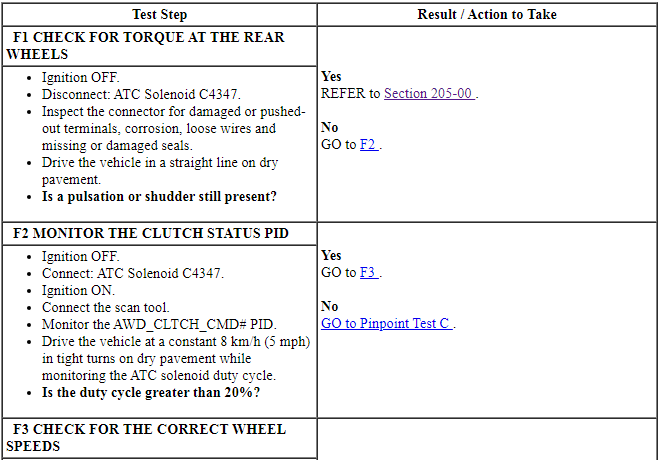
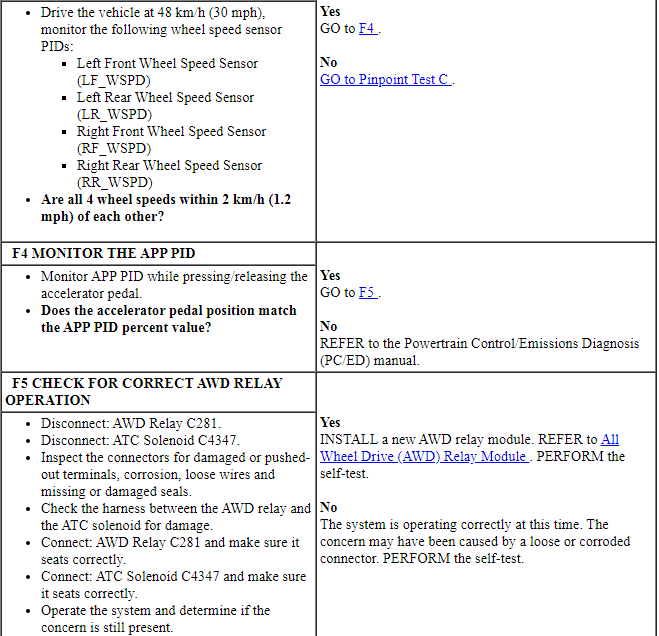

GENERAL PROCEDURES
Automatic Torque Coupling (ATC) Configuration
- Using the scan tool, under the toolbox icon select Powertrain then select ATC Barcode Entry. Follow the instructions displayed on the scan tool.
NOTICE: If the ATC bar code information is not correct, RDU damage or driveability concerns can occur.
- Enter the 4-digit numeric bar code found on the label. The scan tool verifies the digits entered are valid and displays a message if the information is not valid.
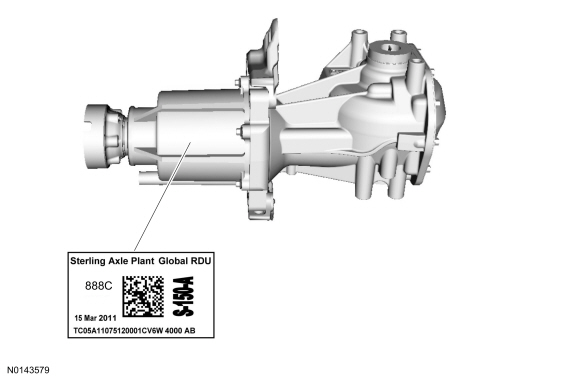
- Follow the instructions displayed on the scan tool.
- Road test the vehicle. Carry out the AWD drive cycle after downloading the ATC solenoid bar code information to the PCM. REFER to All Wheel Drive (AWD) Systems.
Power Transfer Unit (PTU) Oil Life Monitor Reset
NOTE: To reset the PTU oil life monitor after the "Change AWD Power Transfer Unit Lube" message is set and the fluid has been changed, use the following procedure:
- With the vehicle in Park, switch the ignition from the off position to the on position (the engine speed and vehicle speed must be 0 to perform the reset procedure).
- Within 10 seconds of the ignition in the on position, fully apply and completely release the brake pedal 4 times within 10 seconds.
- Within 10 seconds of applying the brake pedal 4 times, push the accelerator pedal to WOT and completely release 4 times within 10 seconds.
- Within 10 seconds of pressing the accelerator pedal 4 times, press and hold both the brake pedal and the accelerator pedal to WOT. After pressing both the brake and accelerator pedals for 5 seconds, a message in the information center displays, " AWD Power Transfer Unit Lube Set to New".
REMOVAL AND INSTALLATION
All Wheel Drive (AWD) Relay Module
Removal and Installation
- Remove the RH cowl side trim panel. Refer to Section 501-05.
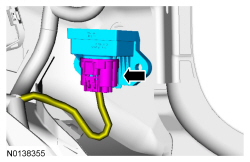
- To install, reverse the removal procedure.
 Transfer Case - Power Transfer Unit (PTU)
Transfer Case - Power Transfer Unit (PTU)
SPECIFICATIONS
Material
Torque Specifications
a Refer to the procedure in this section.
DESCRIPTION AND OPERATION
Power Transfer Unit (PTU)
The AWD system consists of the following:
...
Other materials:
Child safety locks
The childproof locks are located on the rear edge of each rear door and
must be set separately for each door.
When these locks are set, the rear
doors cannot be opened from the
inside.
• Insert the key and turn to the
lock position (key horizontal) to
engage the childproof locks.
• ...
Gauges
Type 1
Cluster shown in standard measure – metric clusters similar.
A. Tachometer
B. Information display. See Information displays for more information.
C. Speedometer
D. Fuel gauge
Fuel gauge
Indicates approximately how much fuel is left in the fuel tank (when the
ignition is on). The f ...
Tire care
Information About Uniform Tire Quality Grading
Tire Quality Grades apply to new
pneumatic passenger car tires. The Tire
Quality Grades can be found where
applicable on the tire sidewall between
tread shoulder and maximum section
width. For example:
• Treadwear 200 Traction AA Temperature ...

